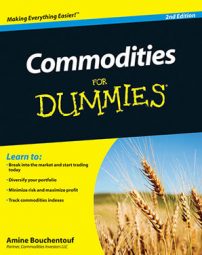Building wealth through investing in commodities takes a lot of time, effort, and discipline — unlike winning the lottery or getting a large inheritance. Achieving your financial goals takes a conscious and systematic effort. Of course, the first part is identifying and establishing your financial goals.
These goals may be as diverse as amassing enough money to retire by age 50 and travel the world, to gathering enough money to pay for college, or to making enough money to pass on to your children or grandchildren. Before you start investing in commodities (or any other asset), sit down and figure out clear financial goals. Every individual has different needs and interests.
You need to know where you are before you can determine where you want to go. From a personal finance perspective, you need to know how much you’re worth so that you can determine how much capital to allocate to investments, living expenses, retirement, and so on.
You calculate your net worth by subtracting your total liabilities from your total assets. (Assets put money in your pocket, whereas liabilities remove money from your pocket.)
Fill in the blanks to determine the total value of your assets.
| Assets | Value |
|---|---|
| Annuities | $_______ |
| Bonds and other fixed income | $_______ |
| Cash in all checking and savings accounts | $_______ |
| Cash on hand | $_______ |
| Certificates of deposit (CDs) | $_______ |
| Commodity investments | $_______ |
| Futures and options | $_______ |
| Individual retirement accounts (IRAs) | $_______ |
| Life insurance | $_______ |
| Money market funds | $_______ |
| Market value of home | $_______ |
| Market value of other real estate | $_______ |
| Mutual funds | $_______ |
| Pension plans (401(k) and/or 403(b)) | $_______ |
| Personal belongings (home furnishings, jewelry, and so on) | $_______ |
| Stocks and other equity | $_______ |
| Vehicles (car, boat, and so on) | $_______ |
| Other investment assets | $_______ |
| TOTAL VALUE OF ASSETS | $_______ |
Assets are only one part of the net worth equation. After you calculate your total assets, you need to determine how many liabilities you have.
| Liabilities | Value |
|---|---|
| Car loans | $_______ |
| College loans | $_______ |
| Credit card loans | $_______ |
| Mortgage(s) | $_______ |
| Mortgage equity line | $_______ |
| Other loans | $_______ |
| TOTAL VALUE OF LIABILITIES | $_______ |
After you determine both your total assets and total liabilities, use the following formula to determine your total net worth:
Total net worth = Total assets – Total liabilities
Determining your net worth on a regular basis is important because it allows you to keep track of the balance between your assets and liabilities. Knowing your net worth allows you to then determine which investment strategy to pursue.
Based on this simple mathematical formula, the key to increasing your net worth is to increase your assets while reducing your liabilities. Investing helps you increase your assets. Cutting down on living expenses may help you reduce your liabilities.

